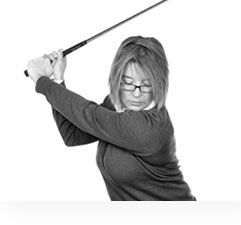 Natalie Adams – PGA Teaching Pro
Natalie Adams – PGA Teaching Pro
A lot of golfers like to see a ball flight that moves right to left in the air as this is what most of the better players do. But excessively moving the ball right to left into what’s called the hook rather than a draw can lead to very destructive shots especially when you’re in play on the course. So a hook has a tendency that it’s moving too much the left. It will start on the right or towards the target but finish much too far left of it, whereas a draw starts on the right of the target and just gently moves into and finishes on the target. It’s predominantly caused with a very aggressive into out — in swing path and the club face is very closed. One of the reasons that this can happen, is that the hands are not moving correctly with the body and the hands are slowing down and too much hand action comes in to close the club face.
So to correct this, what you want to work on is when you’re at the top of the swing, rather than the club head overtaking the hands and getting into this position, which will then excessively close the face and cause the hook to come in. Work on swinging down, feel like you’re puling and being much more dominant with the left hand, keeping the right hand passive and work on keeping the club with the handle of the club, ahead of the club head. So lead through with the hands, lead through with the handle of the club, keep the club head behind the hands and also feeling that the left hand’s doing more of the work and just holding the club face off, will give you slightly more open club face impact and start to straighten those shots out.
So if we work on that on the range, we’re going to lead with the left hand as we swing in, really keep the hand forward, so the club head behind, we’re going to hold the club face off slowly. And then as we come through we’ll see just a gentle draw creeping back in rather than that excessive hook which can be destructive on the course.





